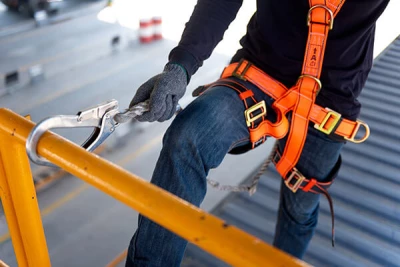Heart Attacks
Published 2.7.2023
February is the month dedicated to raising awareness about our Cardiovascular Health! According to the CDC, there are over 735,000 Americans who suffer from heart attacks each year. In your lifetime, there is a high chance you will witness someone suffer from a heart attack or may even have one yourself.
WHAT IS A HEART ATTACK?
A heart attack, also known as a "myocardial infarction" occurs when the blood to the heart is blocked. The interrupted blood flow damages and destroys part of the heart muscle. As we all know, they can be fatal, but thankfully medication and awareness has helped save thousands of lives.
WHAT ARE A FEW SIGNS AND SYMPTOMS OF A HEART ATTACK?
- Chest discomfort
- Neck and jaw pain
- Fatigue
- Nausea, vomiting, or indigestion
- Radiating pain in one or both arms
- Shortness of breath
- Lightheadedness or dizziness
- Cold sweats
WHAT SHOULD YOU DO IF YOU SUSPECT SOMEONE IS HAVING A HEART ATTACK?
- Immediately call 911 and get emergency responders in route.
- Have them sit down, rest, and try to keep them calm.
- Loosen any tight clothing they may have on.
- Ask if they take any medications for a heart condition, such as nitroglycerin. If they do, help them take it.
- Administer CPR if they lose consciousness or stop breathing before EMS arrives.
What NOT to do if you suspect someone is having a heart attack:
- DO NOT leave them alone, except to phone for help.
- DO NOT wait to see if the symptoms go away.
- DO NOT allow the person to deny symptoms or talk you out of calling for help.
- DO NOT give them anything by mouth, unless it is their own prescribed heart medication.
No one plans on having a heart attack, however there are several ways to prevent one:
- Eating a healthy balanced diet of fruits, vegetables, proteins, and fats.
- Regularly exercising
- Limiting alcohol consumption
- Limiting smoking practices
REMEMBER THIS!
TAKE HEART ATTACK SYMPTOMS SERIOUSLY. WE KNOW MOST OF THE PEOPLE WE WORK WITH PRETTY DARN WELL; IF SOMETHING SEEMS WRONG, TALK TO THEM, OR GET A SUPERVISOR INVOLVED.
Sudden Cardiac Arrest & Automated External Defibrillators
Published 2.14.2023
The list of possible medical emergencies you can experience in life is a long one. A common medical emergency that takes the lives of many people are emergencies that involve the heart. Sudden Cardiac Arrest is different than a heart attack since the heart suddenly stops beating altogether whereas blood can still flow during a heart attack. Sudden cardiac arrest is an issue involving the electrical impulses of the heart. Essentially, the lower chambers of the heart suddenly become chaotic, causing the heart to stop pumping blood, unless the heart returns to a normal rhythm, death can occur in minutes. SCA's are not predicable, they can strike anyone anytime and anywhere.
There are four critical steps in the chain of survival that should be used to treat a sudden cardiac arrest, according to the American Red Cross, American Heart Association, and American Safety & Health Institute:
- Early access to care - Call 911 immediately.
- Start effective CPR as soon as possible.
- Defibrillate as soon as possible (AED).
- Early advanced cardiac life support.
All these steps increase a victim's survival rate, but defibrillation is seen as the most critical step.
WHAT IS DEFIBRILLATION?
It is an external electrical current that "resets" and returns irregular heartbeat to a normal rhythm. Defibrillation is most successful when done within 4 minutes of the collapse. The tool we have available to maximize those odds is the Automated External Defibrillator or AED.
While proper training in CPR and AED management are two crucial parts of successfully helping someone survive a sudden cardiac arrest, todays AEDs can be used by someone with little to no training. There are instructions for pad placement and the rescuer(s) are guided by voice-prompts including when it's safe to touch the patient, when to continue CPR, and when a shock is advised. AEDs are often the only chance that a victim of sudden cardiac arrest will survive.
REMEMBER THIS!
STUDIES HAVE SHOWN THAT IF DEFIBRILLATED WITHIN THE FIRST MINUTE OF COLLAPSE, THE VICTIM'S CHANCES FOR SURVIVAL ARE CLOSE TO 90%. FOR EVERY MINUTE THAT DEFIBRILLATION IS DELAYED, SURVIVAL DECREASES BY 7-10%. IF IT IS DELAYED BY MORE THAN 10 MINUTES, THE CHANCE OF SURVIVAL IN ADULTS IS LESS THAN 5%.
Emergency Planning for Construction Sites
Published on 2.21.2023
As creatures of habit, we often do things "routinely" without thinking about them. Remember your routine this morning? Did you go through the motions without much thought? On the jobsite, do you take the same path "automatically"? This is not necessarily wrong, because your routines often save time and energy. But when it comes to emergency situations involving escape and evacuation, people tend to use the most familiar route too. Sometimes that route may not be the best way to escape.
To ensure your safety and well-being, it is important to prepare carefully for emergencies. In the ever-changing construction environment, this is particularly important. Construction sites are continuously faced with changes in the physical layout, changes in emergency devices available and in harmful exposures. Careful pre-planning of emergency procedures, prior to the start of a project and during changes in different construction phases, must be done and all crew members must be aware of these procedures.
The following steps are important components of an emergency action plan:
- Get to know the entire layout of the site, building or structure. Identify all the emergency exits, emergency equipment (fire extinguishers, eye wash stations, first aid, AED equipment, etc.). Make sure you also know the location of rally points or marshalling areas.
- Analyze potential emergency situations at your jobsite. Will the hazards change regularly or gradually stay the same over a period of time? I believe and practice a state of hypervigilance to continuously monitor the situations I am in.
- Know who has responsibility during emergencies. Who is assigned to contact emergency personnel and who is allowed to talk to the media.
- Practice the emergency procedures to ensure their effectiveness.
- Remember that emergency procedures must be updated whenever there is a change in the operation, hazardous exposures, physical layout or if new employees are working in the location. Our weekly safety meetings are a great time for review.
REMEMBER THIS!
THE LAST THING YOU WANT TO THINK ABOUT DURING AN EMERGENCY IS HOW TO EVACUATE OR ESCAPE - ESPECIALLY, IF YOUR MOST FAMILIAR ROUTE IS NOT ACCESSIBLE. KNOWING THE EMERGENCY PLAN AND BEING AWARE OF SURROUNDING CONDITIONS CAN MEAN THE DIFFERENCE BETWEEN QUICK ACTION AND THE WRONG ACTION. YOUR SAFETY AND THE SURVIVAL OF ALL CREW MEMBERS DEPENDS ON TAKING THE RIGHT ACTION!
Bloodborne Pathogens
Published 2.28.2023
Bloodborne pathogens may not be a hazard that we face everyday in our work environment, but it is important that we are aware of these hazards and know what to if we are faced with them.
Bloodborne pathogens may be transmitted when blood or other infectious body fluids come in contact with our mucous membranes (eyes, nose, mouth), non-intact skin (cuts, abrasions, burns, etc.), or by handling or touching contaminated materials or surfaces. They can also be transmitted by "injection" under the skin via a contaminated sharp object puncturing or cutting the skin, therefore causing a wound.
Individuals who are infected with Hepatitis B, Hep. C, or HIV, may not show symptoms and may not even know they are infectious. For this reason, all blood and body fluids should be considered as infectious, and all precautions should be taken to avoid contact. To reduce your risk of infection, remember to protect yourself first and treat the victim second.
Putting the idea to use, we have Bloodborne Pathogen Kits in every gang box. Inside that kit is a pair of exam quality vinyl gloves, an eye shield with ear loop mask, a disposable gown with full sleeves, a disposable head bonnet, disposable shoe covers, antiseptic towelettes, a red biohazard bag with a closure tie, and a CPR kit. These barrier devices greatly reduce the risk of exposure to potentially infection materials.
Here are some things to remember when responding to injuries:
- If a coworker has a minor accident that causes bleeding, try to have them bandage their own wound until you have put on the appropriate PPE.
- If the injury is serous, call emergency services or 911.
- If you don't have time to wait for the emergency services, make sure you take universal precautions and protect yourself first by treating all bodily fluids as infectious.
- Remove gloves and other protective equipment in a manner that prevents exposures.
- Place all contaminated items in appropriately marked bags or containers.
- Give all contaminated bags and containers to emergency crews or clinic staff for proper disposal.
- If you have been exposed to a victim's bodily fluid, wash the affected area thoroughly with soap and water. Contact a medical professional and report the incident to the safety department immediately.





